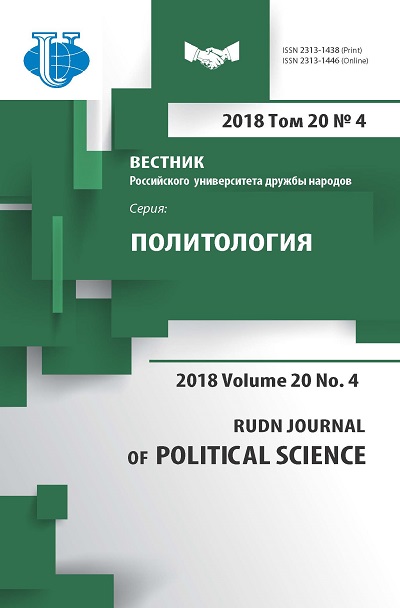SINGLE-PARTY DOMINANCE IN ETHIOPIA: FPTP ELECTORAL SYSTEM AND PARLIAMENTARY GOVERNMENT SYSTEM AS CONTRIBUTING FACTORS
- Autores: Bayeh E.1
-
Afiliações:
- Ambo University
- Edição: Volume 20, Nº 4 (2018)
- Páginas: 506-515
- Seção: POLITICAL PROCESSES IN CONTEMPORARY WORLD
- URL: https://medbiosci.ru/2313-1438/article/view/340003
- DOI: https://doi.org/10.22363/2313-1438-2018-20-4-506-515
- ID: 340003
Citar
Texto integral
Resumo
The primary objective of this paper is to reveal the role of the FPTP electoral system and the parliamentary government system in reinforcing single-party dominance in Ethiopia. For this purpose, the author uses secondary sources of data in his research. The data analysis showed that both the FPTP electoral system and the parliamentary government system have contributed substantially to the existing single-party dominance in Ethiopia. The FPTP electoral system encouraged a single-party rule by awarding seat advantage in parliament to the stronger party, EPRDF. The parliamentary government system has also promoted single-party dominance across all branches of the government by vesting parliament sovereignty with the EPRDF. The researcher comes to the conclusion that due to the inequality of perspectives and opportunities for all political parties (or no genuine multi-party system), the FPTP electoral system and the parliamentary government system inevitably contribute to the development of single-party dominance, which may further lead to authoritarianism.
Palavras-chave
Sobre autores
Endalcachew Bayeh
Ambo University
Autor responsável pela correspondência
Email: endbayeh@gmail.com
PhD in Political Science, Senior Lecturer of Department of Civics and Ethical Studies, College of Social Sciences and Humanities, Ambo University (Ethiopia)
19, Ambo, EthiopiaBibliografia
- Adem A. Rule by law in Ethiopia: Rendering Constitutional Limits on Government Power Nonsensical. CGHR Working Paper 1. Cambridge: University of Cambridge Centre of Governance and Human Rights; 2012.
- Alemayehu G. Cartoon Democracy: Ethiopia's 2010 Election. International Journal of Ethiopian Studies. 2011; 5(2): 27-51.
- Arriola L.R., Lyons T. Ethiopia: The 100% Election. Journal of Democracy. 2016; 27(1): 77-88.
- Bogaards M. Counting Parties and Identifying Dominant Party Systems in Africa. European Journal of Political Research. 2004; 43: 173-197.
- Chege M. Political Parties in East Africa: Diversity in Political Party Systems. Stockholm: International IDEA; 2007.
- Cheibub J., Elkins Z., Ginsburg T. Beyond Presidentialism and Parliamentarism. British Journal of Political Science. 2013: 1-30. doi: 10.1017/S000712341300032X.
- Dahla C. The Ethiopian Quest for Democracy in a Dominant Party State: A Case Study on Democratization in Ethiopia Since the Implementation of Ethnic Federalism in 1995. Master Thesis, Leiden University; 2012.
- Doorenspleet R., Nijzink L. One-Party Dominance in African Democracies: A Framework for Analysis. Doorenspleet R., Nijzink L. (eds), One-Party Dominance in African Democracies. USA: Lynne Rienner Publishers; 2013.
- Gerring J. Minor Parties in Plurality Electoral Systems. Party Politics. 2005; 11 (1): 79-107.
- Gudeta K., Alemu K. Ethiopian Opposition Political Parties in the Post-1991 Political Structure. International Journal of Current Research. 2014; 6 (1): 4784-4799.
- Horowitz D. Electoral Systems and Their Goals: A Primer for Decision-Makers. Duke University; January 2003. Available at: http://cic.nyu.edu/sites/default/files/e6electoralsystems horowitz.pdf. Accessed: 10.09.2018.
- Ishiyama J. Alternative Electoral Systems and the 2005 Ethiopian Parliamentary Election. African Studies Quarterly. 2009; 10 (4): 38-56.
- Johari J.C. Principles of Modern Political Science. New Delhi: Terling Publishers Pvt.Ltd.; 1996.
- Kassahun B. Party Politics and Political Culture in Ethiopia. Salih M (ed.), African Political Parties: Evolution, Institutionalisation and Governance. London: Pluto Press; 2003.
- Molomo M. In Search of an Alternative Electoral System for Botswana. Pula: Botswana Journal of African Studies. 2000; 14 (1): 109-121.
- Newton K., Deth J. Foundations of Comparative Politics. UK: Cambridge University Press; 2005.
- Oseni B. One-Party Dominant Systems and Constitutional Democracy in Africa: A Comparative Study of Nigeria and South Africa. PhD Dissertation. University of Exeter. 2012.
- Reynolds et al. The International IDEA Handbook of Electoral System Design. Stockholm: International Institute for Democracy and Electoral Assistance; 2002.
- Shugart M. Semi-Presidential Systems: Dual Executive and Mixed Authority Patterns. French Politics. 2005; 3: 323-351.
- Szilágyi I. Presidential versus Parliamentary Systems. AARMS. 2009; 8 (2): 307-314.
- Tesfaye A. Identity Politics, Citizenship, and Democratization in Ethiopia. International Journal of Ethiopian Studies. 2006; 2 (1/2): 55-75.
- The Constitution of Federal Democratic Republic of Ethiopia. Proclamation No. 1/1995.
- Veen E. Perpetuating Power: Ethiopia’s Political Settlement and the Organization of Security. CRU Report. The Netherlands: Netherlands Institute of International Relations ‘Clingendael’; 2016.
- Warioba I. The First-Past-The-Post Electoral System versus Proportional Representation in Africa: A Comparative Analysis. Master’s Thesis. Eduardo Mondlane University, Mozambique; 2011.
- Wilks-Heeg S., Crone S. Is ‘first-past-the-post’ working? An Audit of the UK’s Electoral System. AV Referendum Briefing. No. 1. Liverpool: Democratic Audit; 2011.
- Wondwosen T. Ethnicity and Political Parties in Africa: The Case of Ethnic-Based Parties in Ethiopia. The Journal of International Social Research. 2008; 1 (5): 781-809.
- Wondwosen T. Ethiopian Opposition Political Parties and Rebel Fronts: Past and Present. International Journal of Social Sciences. 2009; 4 (1): 60-68.
- Wondwosen T. Electoral Violence in Africa: Experience from Ethiopia. International Scholarly and Scientific Research & Innovation. 2009; 3 (7): 1653-1677.
- Yonatan F. Ethnic Identity and Institutional Design: Choosing an Electoral System for Divided Societies. The Comparative and International Law Journal of Southern Africa. 2009; 42 (3): 323-338.
Arquivos suplementares








